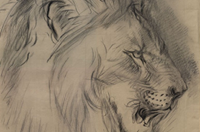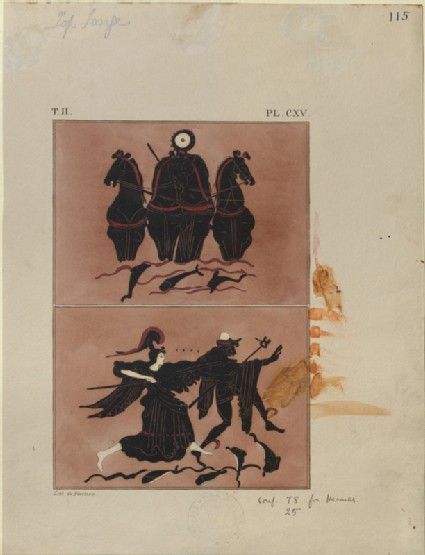Ruskin's Standard & Reference series (1872)
Exemplary works of art. In the catalogue of the Reference series, items marked 'M' are drawings "by my own Hand" (by Ruskin), P are photographs, E engravings and A by Ruskin's Assistant, Arthur Burgess.

Ruskin's Catalogues: 1 object
Show search help- Reference URL
Actions
Print of the Decoration on a Greek Amphora, showing Helios, Athena and Hermes P. Bineteau
-
Ruskin text
Apollo, as the solar power, with Athena and Hermes, as the morning breeze and morning cloud. -
Curator’s description:
Description
The lithograph is arranged in two fields, one above the other. The top one shows Helios in his chariot above three fish. As he faces the viewer, the chariot and the god himself are hidden by the four horses: only the solar disc is visible above the horses' heads. Below, Athena, wearing a helmet and carrying a spear, and Hermes, holding his caduceus, are shown running above the sea. The print reproduces the decoration of a black-figure amphora, then in the Cabinet des Médailles of the Bibliothèque Nationale. It was plate CXV in the second volume of Lenormant and de Witte's "Elite des monuments céramographiques", published in 1857. It was presumably taken from Ruskin's copy of the work now preserved in the Ruskin Library (inventory no. 1996B2621), which is missing many of its plates.
The print was first catalogued by Ruskin in 1870, as no. 204 in the Standard Series, framed with another print from Lenormant and de Witte of a red-figure illustration of Athena and Hermes; they formed part of a series 'arranged chiefly with the view of showing the change in Greek conception of deity'. It retained its number in the 1871 catalogue of the Standard and Reference Series but, by the time Cook and Wedderburn were compiling their edition of the catalogues (published in 1906), the frame had been moved to no. 186. Cook and Wedderburn note (XXI.45 n. 1) that it carried its original number (204) on the edge of its frame, but the new number (186) on the face. Presumably, it was easier to engrave and attach a new ivory label on the edge of the frame than it was to remove or gild over the painted number on the face.
According to Ruskin, the change in the ancient Greek conception of deity took place between the sixth and fourth centuries BC, and was marked by a development from conceiving of the gods as embodiments of physical forces to individual, characterised intelligences; from active to passive figures; and from grotesque to deliberately-selected beautiful depictions. At the same time, ceramic decoration changed from painting black figures on the red ground to painting a black background, letting the red ground show through in the figures themselves - though this soon led to careless execution. He believed the best vases were red-figure vases produced just after the transition (Catalogue of Examples, pp. 25-27; Standard and Reference catalogue, pp. 28-30).
Ruskin described the print as showing 'Apollo, as the Solar Power; with Athena and Hermes, as the Morning Breeze and Morning Cloud'. Discussing the frame in his lecture on "Light" on 16 March 1870, Ruskin expanded upon this development, noting that the figures in this print were 'excessively rude, and of the archaic period; the deities being yet thought of chiefly as physical powers in violent agency', whilst the image below showed 'the repose, and entirely realised personality, of the deities as conceived in the Phidian period' (Lectures on Art, § 153 = XX.145-146). Here, and in "The Queen of the Air", he described how Helios's face was hidden by the light of the sun, and Hermes's by his hair as he turned back to Athena (The Queen of the Air, § 39 = XIX.340). According to Cook and Wedderburn (XIX.lxxviii), the plate had been reproduced as large drawings (then at Brantwood), from which they reproduced plate XVI in their edition of "The Queen of the Air" (XIX, pl. XVI, f.p. 340).
-
Details
- Artist/maker
-
P. Bineteau (active c. 1857 - c. 1858) (printer)
- Object type
- Material and technique
- watercolour and bodycolour over lithograph on wove paper
- Dimensions
- 206 x 144 mm (stone); 309 x 235 mm (sheet)
- Inscription
- All printed, around the image:
top left: T. II.
top right: PL. CXV.
bottom left corner: Lith. de Bineteau.
Recto, in manuscript:
top left, in graphite: Top Large
top right, in ink: 115
below the bottom right corner of the image: Conf. 78 for Hermes. | 25
Verso:
bottom right: R186T
bottom centre, the Ruskin School's stamp
- Provenance
-
Presented by John Ruskin to the Ruskin Drawing School (University of Oxford), 1875; transferred from the Ruskin Drawing School to the Ashmolean Museum, c.1949.
- No. of items
- 1
- Accession no.
- WA.RS.REF.186.a
-
Subject terms allocated by curators:
Subjects
-
References in which this object is cited include:
References
Ruskin, John, Catalogue of Examples Arranged for Elementary Study in the University Galleries (Oxford: Clarendon Press, 1870), cat. Standard no. 204
Lenormant, Charles, and Jean de Witte, Elite des monuments céramographiques: Matériaux pour l'histoire des religions et des moeurs de l'antiquité, 4 vols in 8 (Paris: Leleux, 1844-1861), vol. III, pl. CXV
Ruskin, John, Catalogue of the Reference Series Including Temporarily the First Section of the Standard Series (London: Smith, Elder, [1872]), cat. Reference no. 204
Ruskin, John, ‘The Works of John Ruskin’, Edward T. Cook and Alexander Wedderburn, eds, The Works of John Ruskin: Library Edition, 39 (London: George Allen, 1903-1912)
Ruskin, John, ‘The Ruskin Art Collection at Oxford: Catalogues, Notes and Instructions’, Edward T. Cook and Alexander Wedderburn, eds, The Works of John Ruskin: Library Edition, 39 (London: George Allen, 1903-1912), 21, cat. Reference no. 186
Ruskin, John, ‘Lectures on Art: Delivered Before the University of Oxford in Hilary Term, 1870’, Edward T. Cook and Alexander Wedderburn, eds, The Works of John Ruskin: Library Edition, 39 (London: George Allen, 1903-1912), 20
Ruskin, John, ‘The Queen of the Air: Being a Study of the Greek Myths of Cloud and Storm’, Edward T. Cook and Alexander Wedderburn, eds, The Works of John Ruskin: Library Edition, 39 (London: George Allen, 1903-1912), 19
Location
-
- Western Art Print Room
Position in Ruskin’s Collection
Ruskin's Catalogues
-
Ruskin's Catalogue of Examples (1870)
Apollo, as the solar power, with Athena and Hermes, as the morning breeze and morning cloud. -
Ruskin's Standard & Reference series (1872)
Apollo, as the solar power, with Athena and Hermes, as the morning breeze and morning cloud.





